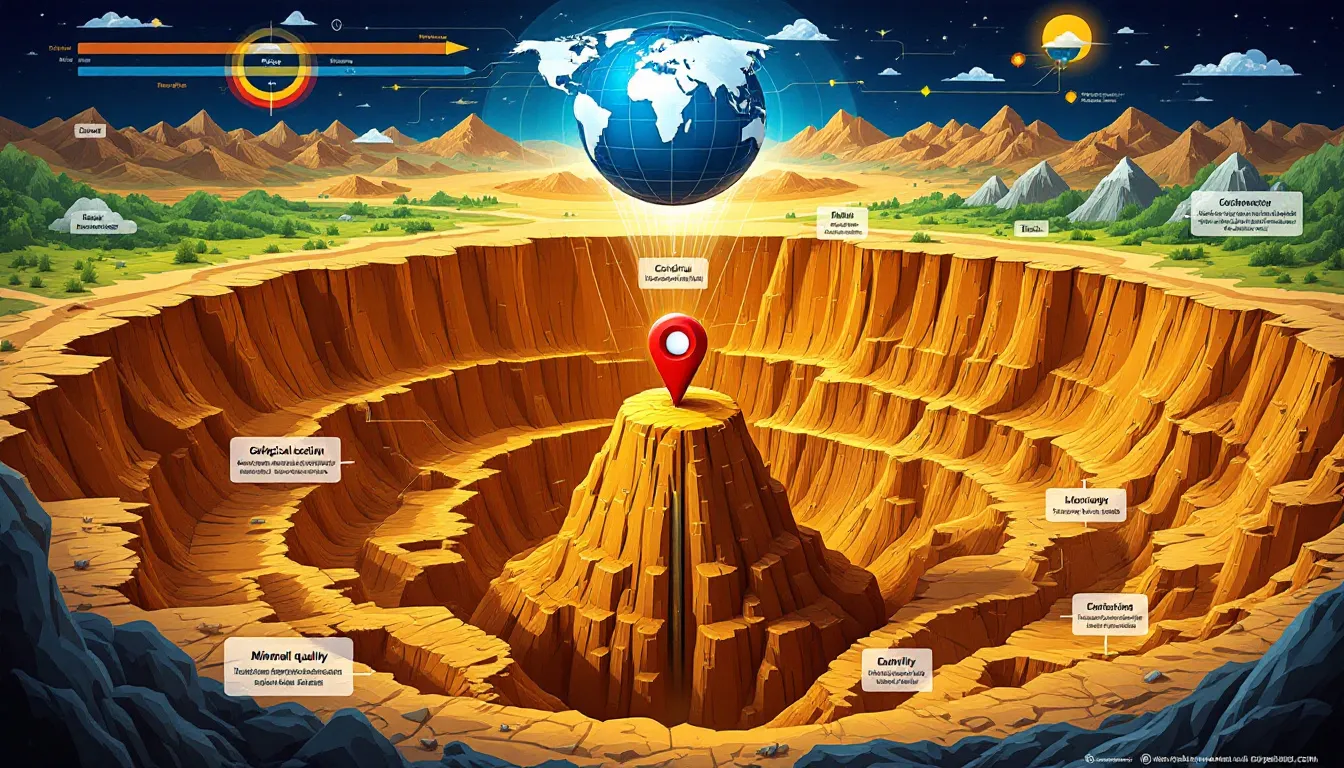Published: Nov 08, 2024 | Updated at: Nov 08, 2024
Do you know who owns the valuable resources beneath your land? Mineral rights determine who can extract and profit from resources like oil and gas under your property. This article explains what mineral rights are, how they work, and their impact on property value.
Key Takeaways
Mineral rights ownership can be separate from surface land ownership, allowing distinct control over subsurface resources, which can significantly influence property value, especially in resource-rich areas.
The value of mineral rights is determined by several factors, including location, type of minerals, and market conditions, with producing rights generally commanding higher valuations than non-producing rights due to active extraction.
Navigating the legal aspects of mineral rights involves understanding various ownership structures, lease agreements, and compliance with environmental regulations, necessitating careful management and potential consultations with legal experts.
What Are Mineral Rights: Ownership, Value, and Legal Aspects

Mineral rights are the legal authority to explore and extract resources like oil and gas beneath a property’s surface. Governed by the ad coelum doctrine, these rights imply ownership extends from the surface to the earth’s center. This concept allows for a unique separation where ownership of mineral rights can be distinct from the ownership of the surface land, enabling different parties to control these rights.
In the United States, owning land does not automatically grant ownership of the underlying mineral rights. This separation can significantly influence property value, especially in resource-rich areas. Lease agreements allow mineral rights owners to earn royalties while retaining ownership of the minerals. Owners can extract, sell, or use these resources, influencing the property’s financial potential.
Documents like deeds and leases clarify mineral rights ownership and ensure compliance with environmental regulations during extraction. Mineral rights ownership grants the holder control over subsurface resources, a key aspect of property rights.
Introduction
In certain states, specific disclosure laws regarding mineral rights in real estate transactions have become increasingly common, underscoring the need for transparency in property dealings. These entitlements permit individuals to extract and sell subsurface resources, enhancing property ownership and value.
The presence and value of mineral rights can significantly boost the overall worth of real estate, especially in areas rich in natural resources. Whether managing a new development or a family property, understanding mineral rights offers a competitive edge in real estate.
Defining Mineral Rights

Mineral rights refer to the legal authority to explore and extract underground resources like oil, gas, metals, and quarry materials beneath a property. These rights can be distinct from surface land ownership, allowing different parties to control surface and subsurface resources. This separation can significantly influence the property’s value, especially in areas abundant in natural resources.
Legal documents like deeds and leases clarify mineral rights ownership and ensure environmental regulation compliance. Mineral rights allow the owner to oversee the extraction and sale of resources, a critical component of property ownership.
Types of Mineral Estates
Mineral estate refers to the ownership rights related to the extraction of minerals from beneath the surface of a property. These estates can be categorized into three primary types: unified estates, severed or split estates, and fractional ownership.
Each type has its unique characteristics and implications for property owners and mineral rights holders.
Unified Estate
A unified estate occurs when both surface rights and mineral rights are owned by the same party, providing full control over all resources, including the surface estate. This type of estate simplifies property management and resource extraction, as the owner has comprehensive ownership rights over the land.
Severed/Split Estate
In a severed or split estate, the ownership of mineral rights is separated from surface ownership, leading to different entities owning each estate. This means the property owner may not own the minerals beneath their land, while the mineral rights owner can develop those minerals independently.
This kind of estate often results from selling mineral rights separately from the land or through inheritance.
Fractional Ownership
Fractional ownership arises when mineral rights are split among multiple parties, complicating management and decision-making.
Multiple owners must coordinate to agree on exploration, extraction, and sale of minerals.
Surface Rights vs. Mineral Rights

Surface rights pertain to the ownership of the land’s surface for residential, agricultural, or commercial use, allowing for activities like farming, building, and ranching. In contrast, mineral and surface rights are the entitlements to explore and extract resources below the surface of the land.
Separating surface and mineral rights can significantly impact property owners. When these rights are divided, different parties may have conflicting interests regarding land use and resource extraction. Recognizing this distinction is key to managing land ownership and maximizing the value of both surface and mineral estates.
Determining Mineral Rights Ownership
Determining mineral rights ownership requires a title search and a review of legal documents. Landowners should undertake extensive research or consult an oil and gas attorney to clarify mineral rights ownership. Examining property documents for terms indicating split or fee simple estates can reveal whether mineral rights are included or severed from the rest of the property.
Reviewing the property deed thoroughly is crucial to confirm the inclusion or exclusion of mineral rights. When inheriting mineral rights, ensuring the title is properly transferred from the estate, possibly involving probate, is crucial. Updating county courthouse records to reflect ownership of inherited mineral rights after they are transferred is a necessary step.
An estate planning attorney can assist in managing and ensuring legal compliance for inherited mineral rights. Verifying mineral rights ownership through a title search after inheritance is essential before managing or transferring those rights.
The Value of Mineral Rights

The value of mineral rights can significantly influence property value, often adding layers of complexity to real estate investments. Property’s mineral rights ownership increases a property’s marketability, particularly in mineral-rich areas.
However, environmental regulations and access issues can significantly impact the profitability and value of these rights.
Factors Influencing Value
The main factors determining the value of mineral rights include location, type of minerals, accessibility, and nearby natural resources. Determining value is complex due to varying prices across regions and land sizes. Market conditions for selling mineral rights can be influenced by the demand for natural resources in the area.
The value of producing mineral rights is influenced by cash flow, drilling stages, property size, and expected royalties. Existing or previous oil operations, number of wells, and exploration activities can alter the average price per acre for producing rights.
The size of the plot, land history, and surrounding area characteristics can influence non-producing mineral rights’ value.
Producing vs. Non-Producing Rights
Producing rights involve active extraction, whereas non-producing rights lack mining operations. Producing minerals generally have a higher value than those not currently extracted. Active extraction significantly increases the valuation of mineral rights compared to those without current production.
Higher well production rates can greatly enhance the overall value of mineral rights. Increased demand for oil and gas development can drive up prices, enhancing the value of mineral rights and providing valuable resources.
Royalty payments to mineral rights holders can vary, typically ranging between 12.5% and 25%.
Leasing and Selling Mineral Rights

Leasing and selling mineral rights are common practices among landowners seeking to monetize their underground resources. These transactions involve agreements with oil and gas companies for resource exploration and extraction.
Oil and Gas Lease Agreements
Mineral rights owners can lease to an oil and gas company, often structuring leases to allow oil and gas operations during a primary term, earning royalties from the extracted resources.
Typical buyers of mineral rights include oil and gas companies and private investors seeking resource opportunities. Lease agreements outline terms and compensation for resource extraction, benefiting both parties.
Selling Mineral Rights
Selling mineral rights requires valuation based on mineral types, reserves, and market demand. This process does not transfer surface rights unless specified in the sale agreement. Owners of a split estate or modified deeds can sell land while retaining mineral rights.
Retaining mineral rights after selling land may reduce the buying pool, as potential buyers might prefer properties with mineral rights. Conversely, keeping mineral rights while forfeiting surface rights can affect the property’s overall value and attractiveness.
Legal Considerations and Surface Use Agreements
The legal framework for mineral rights seeks to balance economic benefits with environmental protection. Mineral rights owners must adhere to environmental regulations during extraction activities. Surface use agreements balance the interests of landowners and those extracting subsurface resources.
A surface use agreement (SUA) is a contract outlining the development of mineral rights between a property owner and the rights holder. These agreements typically include compensation terms for landowners, detailing payment structures for land use and mitigating conflicts.
Inheriting and Transferring Mineral Rights
Inheriting and transferring mineral rights require specific processes to ensure proper ownership and management.
A Mineral Manager can offer personalized assistance and guidance on these issues.
Inheriting Mineral Rights
After inheriting mineral rights, individuals have several options, including retaining, selling, or leasing these rights. Mineral rights ownership can be fractionalized, allowing multiple heirs to share inherited rights. Upon death, mineral rights can be transferred via a will or state intestate succession laws.
A divorce decree is necessary for valid transfers if mineral rights are part of a divorce settlement. Trusts can hold and manage mineral rights, offering a structured means of transferring ownership.
Transferring Ownership
Transferring mineral rights ownership involves completing specific documents and filing them with local authorities. This usually involves preparing a mineral deed that must be executed and filed with local authorities. Legal assistance is often needed to navigate state-specific laws.
To transfer inherited mineral rights, verify the will and file the necessary paperwork with the local deed office. This ensures the transfer is legally binding and recognized by all relevant parties.
Taxes and Mineral Rights
Taxes significantly impact the value and financial return for mineral rights owners. Property taxes typically do not apply to non-producing mineral rights. However, oil and gas royalties are subject to associated taxes.
Understanding tax implications helps mineral rights owners manage assets effectively and maximize financial benefits. Proper tax planning and compliance ensure the profitability of mineral rights investments.
Searching Mineral Rights Owners with Halsell Maps
Halsell Maps is a powerful tool that allows users to search for mineral rights owners and gain insights into their ownership percentages in specific oil and gas leases. This platform provides detailed information on the type of mineral interest owned, appraisal value, making it an invaluable resource for property owners, investors, and mineral rights holders.
Steps to Search for Mineral Rights Owners
Access Halsell Maps: Begin by visiting the Halsell Maps website and logging into your account. If you don't have an account, you'll need to create one to access the full range of features.
Locate the Property: Use the search function to locate the property of interest. You can search by address, parcel number, or coordinates to find the specific area you're interested in.
View Mineral Rights Data: Once you've located the property, Halsell Maps will display detailed information about the mineral rights associated with it. This includes the names of mineral rights owners and their contact information, if available.
Check Ownership Percentages: The platform provides data on the ownership percentage each mineral rights owner holds in a particular oil and gas lease. This helps you understand the distribution of ownership and potential influence each owner may have.
Identify Type of Mineral Interest: Halsell Maps also categorizes the type of mineral interest owned, such as royalty interest, working interest, or overriding royalty interest. This classification helps users understand the nature of each owner's stake in the lease.
Analyze Additional Data: Utilize additional features like historical data, lease agreements, and drilling activity reports to gain a comprehensive understanding of the property's mineral estate.
By leveraging Halsell Maps, users can efficiently navigate the complexities of mineral rights ownership, making informed decisions about investments, negotiations, or potential acquisitions.
Summary
Understanding mineral rights involves navigating a complex landscape of legal, financial, and practical considerations. From ownership and value determination to the intricacies of leasing, selling, and inheriting mineral rights, this guide has provided a comprehensive overview to help you make informed decisions. Key takeaways include the importance of legal documentation, the impact of mineral rights on property value, and the benefits of connecting with other mineral rights owners.
As you continue your journey in the world of mineral rights, remember that knowledge is power. Stay informed, seek professional advice when needed, and leverage the resources available to you. By doing so, you’ll be well-equipped to maximize the value and benefits of your mineral rights.
Frequently Asked Questions
What are mineral rights?
Mineral rights grant the legal authority to explore and extract valuable resources such as oil, gas, and minerals found beneath a property. Understanding these rights is crucial for landowners and investors alike.
How can I determine if I own mineral rights?
The best way to determine if you own mineral rights is to conduct a title search and review legal documentation, including the property deed. Consulting an oil and gas attorney can further clarify your rights.
What is the difference between surface rights and mineral rights?
The difference between surface rights and mineral rights is that surface rights encompass ownership of the land's surface, whereas mineral rights involve the right to extract resources found underground. These rights can be owned independently of one another.
How are mineral rights valued?
The valuation of mineral rights is primarily influenced by location, the type of minerals present, accessibility, and prevailing market demand. Understanding these factors is essential for accurately assessing their worth.
Can I sell my mineral rights separately from my land?
Yes, you can sell mineral rights separately from your land, but ensure that your sale agreement clearly specifies the terms, as surface rights do not automatically transfer.


